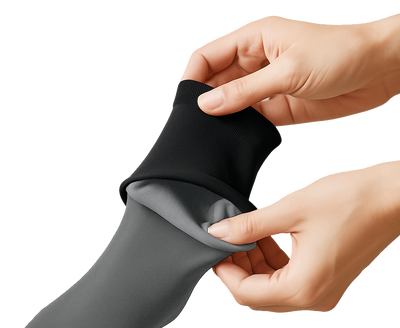Medical Grade Compression Levels
What does mmHg stand for?
You have probably noticed that level of compression is measured in mmHg. This abbreviation stands for millimetres of Mercury. It is the unit used for measuring the pressure that can support 1 column of mercury 1 millimetre high (according to www.dictionary.com)
The Standard Compression Levels
The most standard compression levels are 10-15 mmHg, and 15-20 mmHg. These compressions are mild to moderate, and they can help with minor to moderate problems such as discomfort, occasional swelling, cold or tired feet, etc.
Below you find a list of levels of medical-grade compression with detailed uses and characteristics. This will help you get an idea of how the compression work, and to decide which level of compression may be good for you.
Medical Grade 1
10 to 15 mmHg (mild compression)
- This is a very gentle and mild It is perfect for those who experience a minor ache or general occasional discomfort
- This compression is the best for tired feet after a long day. It is also perfect for workand for house chores. You should see this level of compression as prevention.
- Light compression like this only promotes healthy blood circulation and helps your body stay in the right balance. Prevention is always a good call. You know what they say: “An ounce of prevention is better than a pound of cure.”
10-20 mmHg (moderate compression / over the counter)
- This is the most common level of compression. Moderate squeezing has therapeutic effects. This level of compression is for those who experience frequent aches, tiredness, and numbness. This level of compression is the most used among travelers and pregnant women. Frequent travelers tend to sit for a long period during flight or other transport, so they often feel the heaviness of that in their feet.
- Pregnant women experience swollen legs, varicose veins, and edema, which are all manageable with this level of compression.
20-30 mmHg (firm compression)
- This is s a compression level for those who suffer from more than occasional swelling, pain, cold, and medium to high discomfort. They can also be a good fit for athletes and runners since they help with muscle cramps, and help muscles recover faster after the training.
- If you are only starting now with compression therapy, and you do not have a doctor’s prescription or a notable condition, you should start with a compression of 8 to 15 or 15 to 20 mmHg. If you notice you still feel discomfort with the compression 15 to 20 mmHg, then you should move up a level.
- If you have varicose veins, this level of compression may be the best for you.
Medical Grade 2
30-40 mmHg (extra firm compression)
- This level of compression is an extra firm compression, and it is not meant for those with minor problems. This level of compression is usually suggested or prescribed for people dealing with pain after surgeries, severe aches or swellings, and more developed problems with varicose veins.
- We would not recommend buying the garments with this level of medical-grade compression without consulting a medical professional.
- Even if you feel that the compression of 20-30 mmHg is not helping you, you should talk to your doctor before going to the next level.
Medical Grade 3
What Level of Compression Socks do I need?
- If you are not suggested differently by your doctor, you should not go beyond the level od 20-30 mmHg.
- If you experience minor and occasional you should choose one of the first two levels of compression.
- For most people, the compression of 15-20 mmHg does the work. This compression is mild enough not to have any side-effect or feel odd, and strong enough to help get your body back to its normal functioning and conquer the problems.
For minor discomforts and prevention, always use the first two levels. For more severe problems, consult a medical expert, and let them help you find the best level of medical-grade compression for you.
Contraindications
- People with diabetes, unless under medical supervision
- Significant arterial disease (ischaemia) according to vascular assessment
- Congestive cardiac failure, as compression can lead to cardiac overload
- known sensitivity to the fabric or ingredients or the stockings


